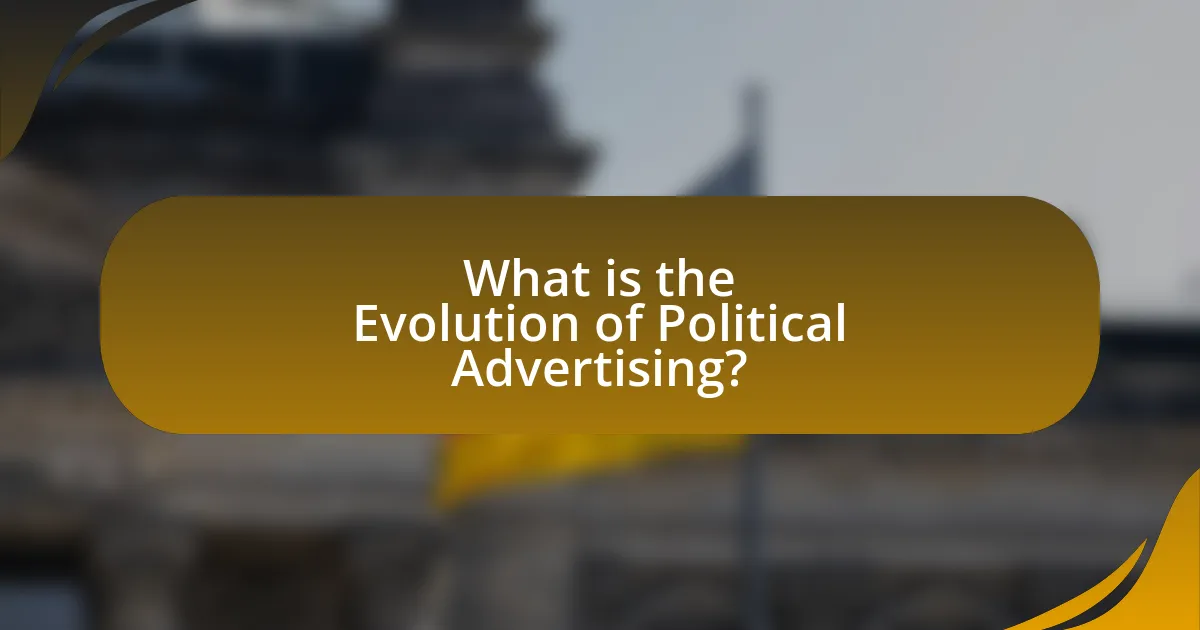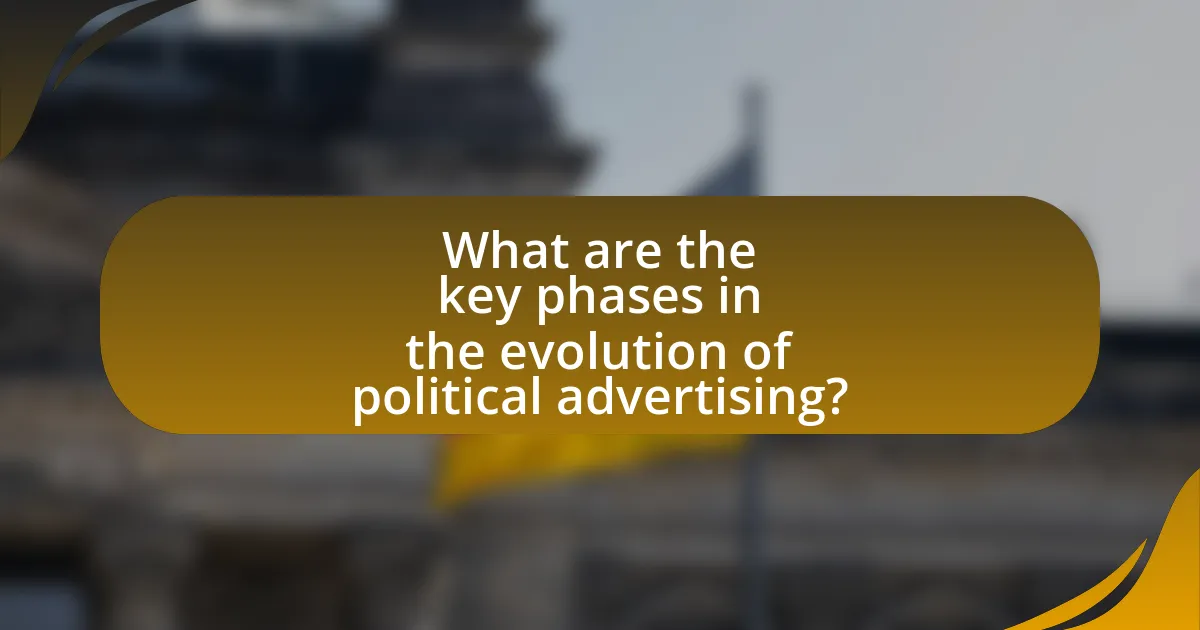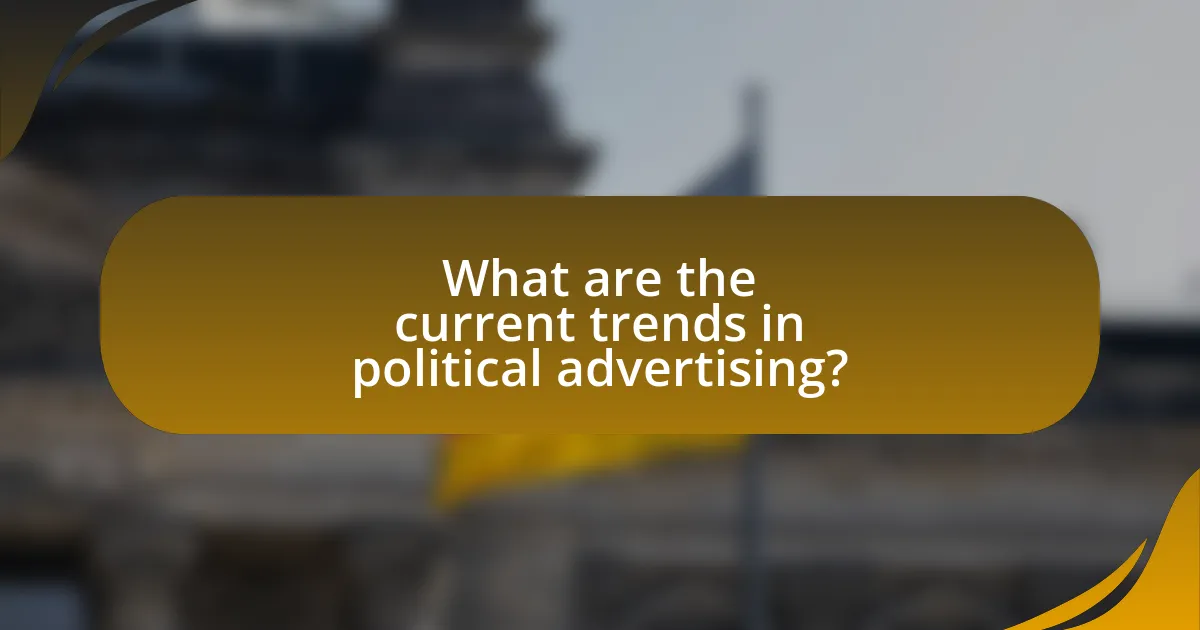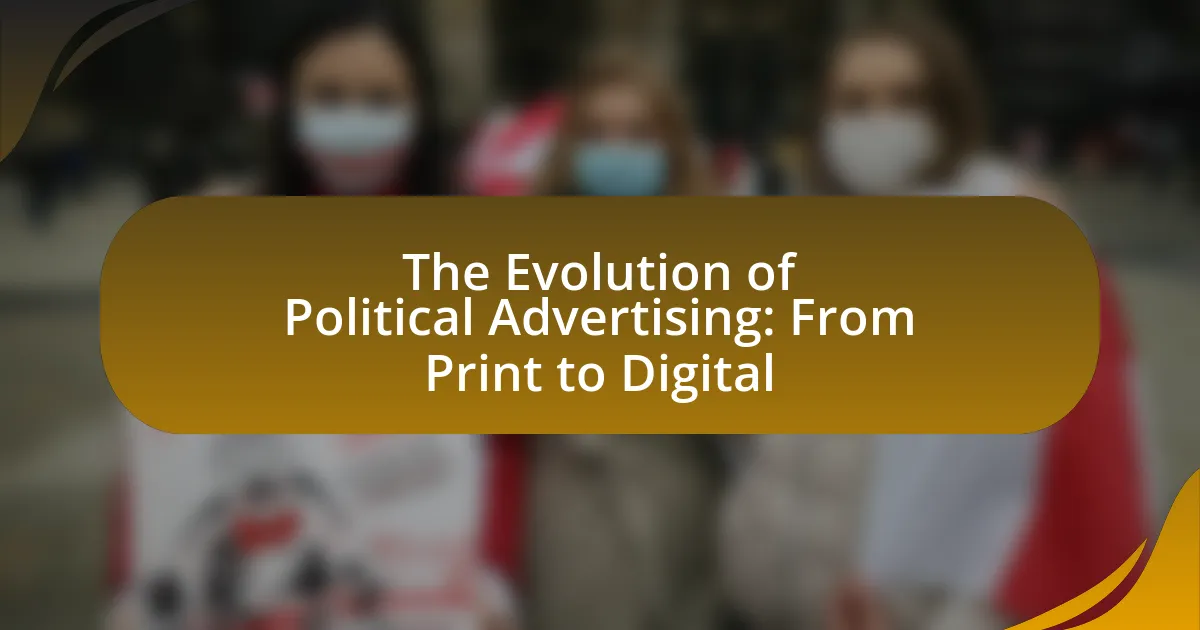The article examines the evolution of political advertising, tracing its development from traditional print media to contemporary digital platforms. It highlights key milestones, including the introduction of radio and television, and the significant impact of social media in recent elections. The discussion emphasizes how technological advancements have transformed voter engagement strategies, with a focus on data analytics and targeted messaging. Additionally, the article addresses the ethical considerations and regulatory frameworks surrounding modern political advertising, providing insights into best practices for effective campaign strategies.

What is the Evolution of Political Advertising?
The evolution of political advertising has transitioned from traditional print media to digital platforms. Initially, political advertising relied on newspapers, pamphlets, and posters to reach voters, with significant milestones such as the first political campaign advertisement in 1824 for Andrew Jackson. The introduction of radio in the 1920s and television in the 1950s revolutionized the medium, allowing candidates to convey their messages more dynamically and reach broader audiences. The 2008 presidential election marked a pivotal moment with the extensive use of social media, enabling targeted advertising and real-time engagement with voters. By 2020, digital advertising expenditures surpassed traditional media, reflecting a shift in strategy as campaigns increasingly utilized data analytics to tailor messages to specific demographics. This progression illustrates the growing importance of digital platforms in shaping political discourse and voter engagement.
How has political advertising changed over the decades?
Political advertising has evolved significantly over the decades, transitioning from traditional print and broadcast media to digital platforms. In the 1950s and 1960s, campaigns primarily relied on newspapers, radio, and television, with limited targeting capabilities. By the 1980s and 1990s, the introduction of cable television allowed for more specialized content, enabling campaigns to reach specific demographics more effectively.
The rise of the internet in the late 1990s and early 2000s marked a pivotal shift, as political advertising began to leverage online platforms for targeted outreach. Social media emerged in the 2010s, further transforming the landscape by allowing campaigns to engage directly with voters, utilize data analytics for micro-targeting, and create viral content.
As of 2020, digital advertising accounted for over 50% of total political ad spending in the United States, reflecting a dramatic shift from traditional methods. This evolution highlights the increasing importance of technology and data in shaping political messaging and voter engagement strategies.
What were the key milestones in the history of political advertising?
The key milestones in the history of political advertising include the introduction of printed pamphlets in the 18th century, the first political campaign using mass media in the 1920s, the advent of television advertising in the 1950s, and the rise of digital advertising in the 2000s. Printed pamphlets allowed candidates to communicate directly with voters, while the 1920s marked the use of radio for political messaging, exemplified by Warren G. Harding’s campaign. The 1952 Eisenhower campaign was pivotal as it utilized television commercials, significantly influencing public perception. The 2008 Obama campaign further transformed political advertising by leveraging social media platforms, demonstrating the effectiveness of targeted digital outreach. Each of these milestones reflects a shift in how candidates engage with voters, adapting to technological advancements and changing media landscapes.
How did technological advancements influence political advertising?
Technological advancements significantly transformed political advertising by enabling targeted messaging and real-time engagement with voters. The rise of digital platforms, such as social media and search engines, allowed political campaigns to analyze voter data and tailor advertisements to specific demographics, increasing the effectiveness of their outreach. For instance, during the 2016 U.S. presidential election, campaigns utilized data analytics to micro-target ads, resulting in a more personalized voter experience and higher engagement rates. This shift from traditional media, like print and television, to digital formats has fundamentally changed how political messages are disseminated and consumed, making advertising more interactive and responsive to voter behavior.
Why is understanding the evolution of political advertising important?
Understanding the evolution of political advertising is important because it reveals how communication strategies have adapted to changing technologies and societal norms. Political advertising has transitioned from traditional print media to digital platforms, reflecting shifts in voter engagement and information consumption. For instance, the rise of social media has transformed how candidates reach and influence voters, with data showing that 69% of adults in the U.S. use social media, making it a critical channel for political messaging. This evolution highlights the need for political campaigns to innovate and tailor their approaches to effectively connect with diverse audiences in an increasingly digital landscape.
What impact does historical context have on current political advertising strategies?
Historical context significantly shapes current political advertising strategies by influencing the methods, messages, and media used in campaigns. For instance, the transition from print to digital advertising reflects historical shifts in technology and communication, such as the rise of television in the 1960s, which introduced visual storytelling and emotional appeal in political ads. This evolution continued with the advent of the internet and social media, allowing for targeted advertising based on user data, a strategy that emerged from earlier practices of voter segmentation. Historical events, such as the Watergate scandal, have also led to increased scrutiny and regulation of political advertising, impacting how campaigns craft their messages to maintain credibility. Thus, understanding the historical context provides insight into the strategic choices made in contemporary political advertising.
How can lessons from the past inform future political campaigns?
Lessons from the past can inform future political campaigns by providing insights into effective messaging strategies and voter engagement techniques. Historical campaigns, such as Franklin D. Roosevelt’s use of radio in the 1930s, demonstrate the importance of adapting communication methods to reach audiences effectively. For instance, Roosevelt’s “Fireside Chats” helped him connect with the American public during the Great Depression, illustrating how personal and relatable messaging can enhance voter trust and support. Additionally, analyzing past campaign failures, like the 2004 presidential campaign’s reliance on negative advertising, reveals that overly aggressive tactics can alienate voters. By studying these examples, future campaigns can refine their approaches, focusing on authenticity and positive engagement to resonate with constituents.

What are the key phases in the evolution of political advertising?
The key phases in the evolution of political advertising include the print era, the broadcast era, the cable and satellite era, and the digital era. The print era, which began in the 18th century, utilized pamphlets and newspapers to disseminate political messages. The broadcast era emerged in the mid-20th century with radio and television, allowing candidates to reach a wider audience through commercials and debates. The cable and satellite era, starting in the 1980s, introduced targeted advertising through niche channels. Finally, the digital era, which began in the 2000s, leverages social media and online platforms for micro-targeting and real-time engagement, significantly transforming how political messages are communicated and consumed. Each phase reflects advancements in technology and changes in audience behavior, shaping the strategies used in political campaigns.
What role did print media play in early political advertising?
Print media served as the primary medium for early political advertising, enabling candidates to reach a broad audience through newspapers, pamphlets, and posters. This form of media allowed for the dissemination of political messages, campaign platforms, and candidate biographies, significantly influencing public opinion and voter behavior. Historical evidence shows that during the 19th century, print media was crucial in shaping electoral outcomes, as candidates like Abraham Lincoln utilized newspapers to communicate their messages effectively, reaching millions of voters. The widespread availability of print media facilitated the rise of political parties and the organization of electoral campaigns, establishing a foundation for modern political advertising strategies.
How did newspapers and pamphlets shape political messaging?
Newspapers and pamphlets significantly shaped political messaging by providing a platform for the dissemination of political ideas and information to a broad audience. These print media allowed politicians and activists to communicate their messages directly to the public, influencing public opinion and mobilizing support. For instance, during the American Revolution, pamphlets like Thomas Paine’s “Common Sense” played a crucial role in rallying colonists against British rule, reaching an estimated 500,000 readers at a time when the population was only about 2.5 million. This widespread distribution of political content through print media established a precedent for future political communication, demonstrating the power of accessible information in shaping democratic discourse.
What were the limitations of print media in political campaigns?
Print media in political campaigns had several limitations, primarily its inability to reach a wide audience quickly and its static nature. Unlike digital media, print media could not provide real-time updates or engage voters interactively. Additionally, print media often faced high production costs and limited distribution channels, which restricted the frequency and volume of messaging. According to a study by the Pew Research Center, only 20% of voters relied on print newspapers for political information in the 2016 election, highlighting the diminishing influence of print media in favor of more immediate and accessible digital platforms.
How did radio and television transform political advertising?
Radio and television transformed political advertising by enabling candidates to reach a broader audience with dynamic audio-visual content. This shift allowed for more engaging and persuasive messaging compared to traditional print media, which was limited to static text and images. For instance, the 1960 presidential debate between John F. Kennedy and Richard Nixon showcased the impact of televised appearances, as Kennedy’s confident demeanor resonated with viewers, while Nixon’s less polished presentation negatively affected his image. This event marked a pivotal moment in political advertising, demonstrating that visual appeal and personality could significantly influence voter perceptions and decisions.
What were the first significant political advertisements on radio and TV?
The first significant political advertisement on radio was the 1924 campaign ad for Calvin Coolidge, which marked the beginning of political advertising in the medium. On television, the first notable political advertisement was the 1952 “Eisenhower Answers America” campaign, featuring Dwight D. Eisenhower, which effectively utilized the new medium to reach voters. These advertisements set a precedent for future political campaigns, demonstrating the power of audio-visual media in influencing public opinion and voter behavior.
How did visual media change voter engagement and perception?
Visual media significantly transformed voter engagement and perception by making political messages more accessible and emotionally resonant. The introduction of television and later digital platforms allowed candidates to convey their messages through compelling visuals and storytelling, which increased voter interest and participation. For instance, studies show that televised debates, such as the 1960 Kennedy-Nixon debate, influenced public opinion by showcasing candidates’ personalities and charisma, leading to a measurable impact on voter behavior. Additionally, social media platforms like Facebook and Twitter have enabled targeted advertising, allowing campaigns to reach specific demographics with tailored messages, further enhancing voter engagement. This shift to visual media has resulted in a more informed electorate, as voters can now consume information in diverse formats, leading to a deeper understanding of political issues.
What is the significance of digital advertising in modern political campaigns?
Digital advertising is significant in modern political campaigns because it allows for targeted outreach, real-time engagement, and cost-effective messaging. Campaigns can utilize data analytics to identify and reach specific voter demographics, enhancing the efficiency of their advertising spend. For instance, a study by the Pew Research Center found that 69% of adults in the U.S. use social media, making platforms like Facebook and Twitter crucial for engaging with potential voters. Additionally, digital advertising enables campaigns to quickly adapt their strategies based on immediate feedback and analytics, which is not possible with traditional print media. This adaptability has been shown to increase voter mobilization and influence public opinion effectively.
How has social media changed the landscape of political advertising?
Social media has fundamentally transformed political advertising by enabling targeted messaging and real-time engagement with voters. Platforms like Facebook and Twitter allow campaigns to segment audiences based on demographics, interests, and behaviors, leading to more personalized and effective advertisements. For instance, during the 2016 U.S. presidential election, the Trump campaign utilized Facebook’s advertising tools to reach specific voter groups, resulting in over 5 million targeted ads that significantly influenced voter perceptions. Additionally, social media facilitates immediate feedback and interaction, allowing candidates to respond to public sentiment swiftly, which traditional media could not achieve. This shift has led to a more dynamic and responsive political advertising landscape, where campaigns can adapt strategies in real-time based on audience reactions and engagement metrics.
What are the advantages and challenges of digital political advertising?
Digital political advertising offers advantages such as targeted reach and cost-effectiveness, while challenges include misinformation and regulatory scrutiny. Targeted reach allows campaigns to deliver tailored messages to specific demographics, enhancing engagement; for instance, platforms like Facebook and Google enable advertisers to focus on users based on interests and behaviors. Cost-effectiveness is evident as digital ads often require lower budgets compared to traditional media, allowing for broader campaign strategies. However, challenges arise from the prevalence of misinformation, which can distort public perception and undermine trust in political processes. Additionally, regulatory scrutiny has increased, with governments implementing stricter rules on transparency and data usage, complicating campaign strategies. These dynamics illustrate the dual nature of digital political advertising, balancing innovative opportunities with significant hurdles.

What are the current trends in political advertising?
Current trends in political advertising include the increased use of digital platforms, data-driven targeting, and the integration of social media strategies. Political campaigns are shifting from traditional media to online channels, with over 70% of campaign spending now allocated to digital advertising, according to the 2022 Campaign Finance Institute report. Additionally, campaigns are leveraging big data analytics to identify and reach specific voter demographics, enhancing engagement and effectiveness. The rise of video content, particularly on platforms like TikTok and Instagram, is also notable, as it allows for more dynamic storytelling and real-time interaction with voters.
How are data analytics and targeting shaping political campaigns today?
Data analytics and targeting are fundamentally transforming political campaigns by enabling precise voter segmentation and personalized messaging. Campaigns now utilize vast amounts of data from social media, online behavior, and demographic information to identify and engage specific voter groups effectively. For instance, the 2020 U.S. presidential election saw candidates leveraging data analytics to tailor their advertisements to resonate with particular demographics, resulting in more efficient allocation of resources and higher engagement rates. According to a study by the Pew Research Center, 72% of voters reported seeing political ads that were specifically targeted to them based on their online activity, illustrating the significant impact of data-driven strategies in modern political advertising.
What tools are used for data-driven political advertising?
Data-driven political advertising utilizes tools such as data analytics platforms, social media advertising, customer relationship management (CRM) systems, and programmatic advertising software. These tools enable political campaigns to analyze voter data, target specific demographics, and optimize ad placements based on real-time performance metrics. For instance, platforms like Facebook Ads and Google Ads allow campaigns to reach targeted audiences based on behavioral data, while CRM systems help manage voter outreach and engagement effectively. The use of these tools has been validated by numerous successful campaigns that leveraged data to enhance their advertising strategies, demonstrating the significant impact of data-driven approaches in modern political advertising.
How does micro-targeting affect voter outreach?
Micro-targeting significantly enhances voter outreach by allowing political campaigns to tailor messages to specific demographics based on data analytics. This approach enables campaigns to identify and engage with potential voters more effectively, as evidenced by the 2012 Obama campaign, which utilized micro-targeting to reach diverse voter segments, resulting in a 5% increase in voter turnout among targeted groups. By analyzing voter behavior, preferences, and demographics, campaigns can deliver personalized content that resonates with individual voters, thereby increasing engagement and support.
What ethical considerations arise in modern political advertising?
Ethical considerations in modern political advertising include misinformation, manipulation of emotions, and the exploitation of personal data. Misinformation can mislead voters, as seen in the 2016 U.S. presidential election, where false narratives spread rapidly on social media platforms. Manipulation of emotions often involves using fear or anger to sway public opinion, which raises questions about the integrity of the democratic process. Additionally, the exploitation of personal data for targeted advertising can infringe on privacy rights, as demonstrated by the Cambridge Analytica scandal, where data from millions of Facebook users was used without consent to influence voter behavior. These factors highlight the need for ethical standards in political advertising to ensure transparency and accountability.
How do misinformation and disinformation impact political campaigns?
Misinformation and disinformation significantly undermine the integrity of political campaigns by distorting public perception and influencing voter behavior. Misinformation refers to false or misleading information shared without malicious intent, while disinformation involves the deliberate spread of falsehoods to deceive. Both can lead to confusion among voters, erode trust in candidates, and skew electoral outcomes. For instance, a study by the Pew Research Center found that 64% of Americans believe fabricated news stories cause confusion about the basic facts of political issues. This confusion can result in voters making decisions based on incorrect information, ultimately affecting the legitimacy of democratic processes.
What regulations exist to govern political advertising practices?
Regulations governing political advertising practices include the Federal Election Commission (FEC) rules in the United States, which require disclosure of funding sources for political ads and prohibit false statements about candidates. The Bipartisan Campaign Reform Act (BCRA) also restricts the timing and content of political advertisements, particularly those funded by corporations and unions. Additionally, many states have their own laws that impose further restrictions on political advertising, such as requiring disclaimers on ads and limiting the use of certain types of funding. These regulations aim to promote transparency and accountability in political advertising, ensuring that voters receive accurate information.
What best practices should political campaigns follow in advertising?
Political campaigns should prioritize transparency, target audience engagement, and data-driven strategies in their advertising efforts. Transparency builds trust with voters, as campaigns that disclose funding sources and ad sponsorship are viewed more favorably. Engaging the target audience through tailored messaging and interactive content enhances voter connection, as studies show that personalized ads can increase engagement rates by up to 50%. Additionally, utilizing data analytics allows campaigns to optimize ad placements and messaging, leading to more effective outreach; for instance, campaigns that leverage A/B testing can improve conversion rates significantly. These best practices are essential for maximizing the impact of political advertising in a rapidly evolving digital landscape.
How can campaigns effectively balance traditional and digital advertising strategies?
Campaigns can effectively balance traditional and digital advertising strategies by integrating both approaches to maximize reach and engagement. Utilizing traditional media, such as television and print, allows campaigns to target broader demographics, while digital platforms enable precise targeting and real-time interaction with specific voter segments. For instance, a study by the Pew Research Center indicates that 53% of voters aged 18-29 primarily consume news online, highlighting the importance of digital strategies for engaging younger audiences. By synchronizing messaging across both channels, campaigns can reinforce their brand and message, ensuring consistency and enhancing overall effectiveness.
What are the key elements of a successful political advertisement?
The key elements of a successful political advertisement include a clear message, emotional appeal, target audience identification, and a strong call to action. A clear message ensures that the advertisement communicates the candidate’s core values and policies succinctly, making it easily understandable for voters. Emotional appeal engages viewers on a personal level, often using storytelling or relatable scenarios to create a connection. Identifying the target audience allows the advertisement to tailor its content and delivery method effectively, ensuring it resonates with specific voter demographics. Finally, a strong call to action motivates viewers to take specific steps, such as voting or visiting a campaign website. These elements have been shown to enhance the effectiveness of political advertisements, as evidenced by studies indicating that emotionally charged messages can increase voter engagement and recall.
